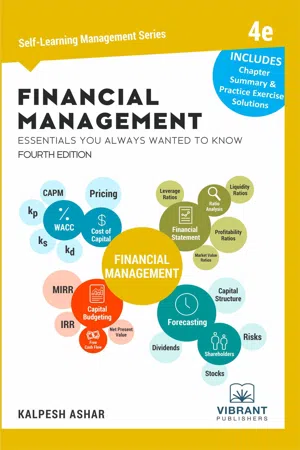
Financial Management Essentials You Always Wanted To Know
4th Edition
- English
- ePUB (mobile friendly)
- Available on iOS & Android
Financial Management Essentials You Always Wanted To Know
4th Edition
About this book
- Includes Chapter Summaries and Solutions to Practice Exercises
- Financial Management concepts simplified
- Fundamentals explained for business professionals and non-finance graduates
- Important standard principles covered
- Solved exercises and practice questions
Financial Management Essentials You Always Wanted To Know: 4th Edition provides new managers and leaders with the foundational concepts of financial management. This book is designed to help students, freshers, management professionals, and new managers navigate the complex world of corporate finance. It provides an overview of core financial concepts such as:
- Analysis of financial statements
- Cost of Capital
- Creating a capital budget
- Managing working capital
- Stocks and dividends
- Forecasting
Each chapter provides clear examples of financial management practices and includes practice exercises to help train the reader in the usage of these critical tools. This edition also includes Chapter Summaries and Solutions to Practice Exercises.
About the Series
The Self-Learning Management Series is designed to help students, new managers, career switchers and entrepreneurs learn essential management lessons. This series has marketing books, management books, accounting books and more, that have been designed to address every aspect of business across every industry. Each book includes basic fundamentals, important concepts, standard and well-known principles, and practical ways of application of the subject matter. The distinctiveness of the series lies in that all the relevant information is bundled in a compact form that is very easy to interpret.
Frequently asked questions
- Essential is ideal for learners and professionals who enjoy exploring a wide range of subjects. Access the Essential Library with 800,000+ trusted titles and best-sellers across business, personal growth, and the humanities. Includes unlimited reading time and Standard Read Aloud voice.
- Complete: Perfect for advanced learners and researchers needing full, unrestricted access. Unlock 1.4M+ books across hundreds of subjects, including academic and specialized titles. The Complete Plan also includes advanced features like Premium Read Aloud and Research Assistant.
Please note we cannot support devices running on iOS 13 and Android 7 or earlier. Learn more about using the app.
Information
Forecasting Financial Statements
Step 1 – Forecast Sales


Step 2 – Forecast Income Statement

Table of contents
- Introduction to Financial Management
- Financial Statement Analysis
- Chapter Summary
- Cost of Capital
- Cost of Debt (ka)
- Capital Budgeting
- Free Cash Flow
- Timing of Cash Flow
- Working Capital Management
- Cash Conversion Cycle
- Capital Structure
- Distribution to Shareholders
- Factors in setting Dividend Distribution Policy
- Forecasting Financial Statements
- Step 1 – Forecast Sales
- Glossary